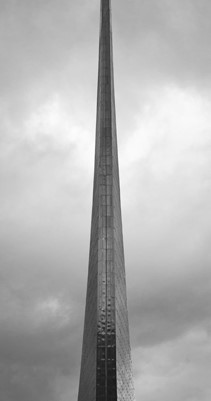The First Marriage
Early in the years of Deia, long before any of the mortal races awakened, and even before any growing thing sprouted and any animal scurried, the Contest of the Pillars was in progress. Vanaya, Domva of the natural world, and Aesteros, Domvar of craftsmanship, had made great creations to determine what vision of the world would win out. The unchanging stone and metal or Æsteros were pitted against the blooming gardens of Vanaya. The contest had just entered its twenty-second century, and the Tree of Vanaya had reached a remarkable size, while the Pillar of Æsteros remained as towering and unchanged as the day it was made.
Æsteros was walking in the land of his Pillar when he caught sight of a woman, who was staring intently at the Pillar. He approached her, and asked who she was and what she was doing. She named herself Supella, the Domva of furnishing, and she told Æsteros that his Pillar was dull. The Domvar was taken aback, for the other Domvari had congratulated him on his work. He told her as much, but she shook her head. "The others do not know beauty." she told him. "They congratulate its size and its longevity, nothing more. I see the potential this work could have. It is too simple, and it doesn't have anything about it that is truly skillful, not to say your work was not difficult, you just lack a more creative vision. Behold that Tree; it began simple, but is designed to grow ever more intricate, and it increases in beauty the longer it stands." Æsteros stood, dumbfounded, and Supella bid him farewell as night began to fall.
Several days passed, and Supella returned to the Pillar, and found Æsteros sitting and staring at it. His expression was frustrated, and he was poring over several schematics in front of him. A great pile of shattered stone tablets and crumpled sheets of metal was scattered behind him. Supella approached him, and asked him what he was doing. He replied, "I am busy finding what's wrong with my work, but I cannot find any flaw. It bears down deeply enough to balance the mass above, it is thick enough to not be torn down by powerful winds, and remains much taller than Vanaya's Tree. My work is perfect, yet you have planted doubt in my mind that will not go away." Æsteros turned to Supella. "What do you see?" he asked her. It was Supella's turn to be dumbfounded, for she had not expected her words to alter the view of Æsteros at all; he had always seemed so sure of his work, dispensing a myriad of sturdy, yet plain, items to the other Domvari with great pride. She said to him, "You see how plain it is, yes? There is not a single mark or design on it. Simplicity can have its own beauty, but not when intricacy is so plainly absent. Our whole world is simple, and if our people wanted to see more simplicity, they would only have to walk several miles in any direction to find it. Even the place where the water meets the land has more intricacy than your Pillar. You're listening, but do you begin to understand me?"
Æsteros was indeed listening, and staring intently at Supella as she spoke. He was silent, and looked to his Pillar. At length he looked back to her and said, "I am beginning to understand, Supella, but I lack any ability to do anything about this, and I am still unsure about how intricacy can be made from metal. Perhaps you can teach me?" Supella, again caught off guard by Æsteros, said "Surely, you don't think I can work metal as you do? If I am to teach you, you will have to show me how your stone and metal are wrought." After a moment of thought, the other replied "Then you will come with me to my forge, where the rock flows like water, and I'll show you how metal is shaped." The two went to the forge which Æsteros had delved deep into the earth. There, he had discovered an immense plume of magma bubbling. He had built strong walls to hold it steady, and used its heat to work his forges in the deeps.
Æsteros was indeed listening, and staring intently at Supella as she spoke. He was silent, and looked to his Pillar. At length he looked back to her and said, "I am beginning to understand, Supella, but I lack any ability to do anything about this, and I am still unsure about how intricacy can be made from metal. Perhaps you can teach me?" Supella, again caught off guard by Æsteros, said "Surely, you don't think I can work metal as you do? If I am to teach you, you will have to show me how your stone and metal are wrought." After a moment of thought, the other replied "Then you will come with me to my forge, where the rock flows like water, and I'll show you how metal is shaped." The two went to the forge which Æsteros had delved deep into the earth. There, he had discovered an immense plume of magma bubbling. He had built strong walls to hold it steady, and used its heat to work his forges in the deeps.
Within the cavernous depths of the world, Æsteros showed Supella the melting of stone and metal, and how easily it could be poured forth into simple shapes. He showed the tools of his work, which could pound and twist and cut the shapes he desired. Pottery too, he showed, working clay into vessels and figures. Stone as well he had sculpted, chiseling precise angles to shape the formless rocks. Supella learned these things, and used her new knowledge of the tools to guide Æsteros in creating finer shapes. She taught him æsthetics, which elaborated on his simple understanding of precision and symmetry. For many years, she helped make tools of detailing, and guided the hands of Æsteros in subtlety and grace. The two grew closer. Æsteros, having learned beauty, began to see it in Supella, and in every delicate movement she made.
Inspired, Æsteros began the undertaking of a great project. He only spoke with Supella when away from his forge, and no longer permitted her entry within. Months carried on. Smoke billowed ever from the chimney of the Forge. At length, Æsteros emerged, gently carrying a large stone block, which he placed at the foot of the Tree of Vanaya. All the Domvari gathered in curiosity, including Supella. Æsteros announced that this was a gift he had made for her, "with only the greatest effort and attention to detail." he added with a sincere smile. She was terribly confused and visibly flustered, as she saw only the simple stone block, and was on the verge of lashing out and rebuking Æsteros for not learning a thing of intricacy from her in all those years. Satisfied, Æsteros took out his hammer and chisel, and, positioning the chisel at one point on the block, struck it with his hammer. The great stone cracked, splintering into a hundred shards of rubble, revealing the statue beneath. It was made in the image of Supella, clad in robes of silver and gold, the marble skin delicately shaped in her visage, and emeralds greener than the leaves of the tree above were set in its eyes. The hands of the statue were rich with rings bearing diamonds more numerous than the stars, and they bore aloft a hammer and chisel of solid gold, as if the statue had carved itself from the rock.
All the Domvari stood in awe of the statue, and Supella herself fell to her knees. As the initial shock and praise died down, Æsteros proclaimed his love to Supella, and asked that she become his wife, for she was his inspiration, and he wished to keep her by his side for eternity. Supella herself had grown deeply fond of him, and seeing how deeply he returned her admiration, she accepted, running into his arms and embracing him. Beneath the Tree of Vanaya, the two were married, for Æsteros now saw the Tree as more beautiful than the Pillar he had made, and wished to wed Supella in its shade. When the Contest between Vanaya and Æsteros ended, and the Pillar was rent apart in a mighty storm, these two were given the honor of constructing Urba, the city of the Domvari, and their combined skill made it the single greatest city to ever grace the world.
The Pillar of Aesteros
A great metal spire, created by Aesteros, which pierced high into the atmosphere of Deia, and once was rooted deep in the world. It was ravaged by a powerful storm which raged periodically for a thousand years, until the metal of the Pillar was warped and rusted, and it fell in upon itself; pieces of the Pillar can still be uncovered in lands as far from its foundation as the hills of Lindon.
The Tree of Vanaya, Vanyassil
An enormous tree, planted by Vanaya, which has grown to touch the skies, and whose roots drink deep from the world. Through the storm that destroyed its competitor, the Pillar of Aesteros, the Tree suffered many wounds, losing entire branches to the wind, and being singed by lightning; however, the Tree stood strong, and recovered from the wounds with time. It still stands where it was planted so many millennia ago, still slowly growing, and its descendants are planted along the streets of Urba, and in a forest that surrounds the grove it occupies.






Comments